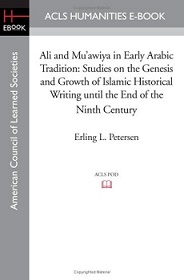Ali and Mu'awiya in Early Arabic Tradition: Difference between revisions
No edit summary |
No edit summary |
||
| (One intermediate revision by the same user not shown) | |||
| Line 30: | Line 30: | ||
== Source == | == Source == | ||
* [https://www.amazon.com/Muawiya-Early-Arabic-Tradition-book/dp/B00FFB4UP0 | * [https://www.amazon.com/Muawiya-Early-Arabic-Tradition-book/dp/B00FFB4UP0 Petersen, ''Ali and Mu'awiya in Early Arabic Tradition''] | ||
{{Bibliography of Imam al-Hussain}} | |||
<br /> | |||
[[Category:Books]] | [[Category:Books]] | ||
[[Category:Works]] | |||
[[Category:Written Works]] | [[Category:Written Works]] | ||
Latest revision as of 10:23, 18 October 2022
 | |
| Author | Erling Ladewig Petersen |
|---|---|
| Language | English |
| Published | 2008 |
| Publisher | ACLS Humanities E-Book |
| Pages | 204 |
The book ALI AND MUAWIYA IN EARLY ARABIC TRADITION presents an attempt to trace the formation of the historical tradition associated with the first civil war by applying modern standards of historical method.
About the author[edit | edit source]
Erling Ladewig Petersen (April 1, 1929 - June 25, 2000) became a student at Lyngby State School in 1948, after which he studied history at the University of Copenhagen. In 1955 he completed his studies with a master's conference and in the following years continued in the position as librarian at the Department of History, which he had held since 1951. In 1959 he was employed as an amanuensis at the department and in 1964 he became Dr.Phil. with the dissertation Ali and Mu'awiya in early Arabic tradition: studies on the Genesis and growth of Islamic historical writing until the end of the ninth century, which dealt with the older Arabic historiography. Ladewig's research activities focused on the early history and writing of Islam, Danish economic and social history in the 16th and 17th centuries and the method of the subject of history.
About the book[edit | edit source]
This book published in ACLS Humanities E-Book (August 1, 2008), has 204 pages and best sellers rank of 5,682,329 in Books. The English translation has been undertaken by Mr. P. Lampe Christensen.
The author in this book tried to establish an outline of the genesis of “profane” historical writing in Islam, in so far as the ‘All-Mu’awiya conflict can be considered paradigmatic. The book thus aims at combining a “historiographical” and methodical study of the early conflicts in Islam.
Abstract of chapters[edit | edit source]
Part I: Genesis of the Tradition[edit | edit source]
This part is about the first record of the historical tradition which belongs to the transition period between the Umayyad and the Abbasid Caliphate; the earliest and more consistent presentation of the prose tradition and those intimations which we know in poetical form can be definitely traced to the preceding generation. What is mentioned in this part, indicated that even in its earliest stages the transmission of ‘All’s Caliphate had been subject to decisive factual shifts in consequence of its inclusion into the topical political disputes during the decades around the year 700. In this period the social and religious discords, which its first seeds were in al-Mukhtar’s rebellion in 685, were deepened, primarily because society’s beginning Islamization engendered serious difficulties.
Part II: The First Century of the Abbasid Era[edit | edit source]
This part is about the Umayyad period’s attempts to meet the beginning islamization of the social system. The islamization process was, admittedly, accomplished during the following generations, but the vertical cleavage between Arabs and mawdli was replaced by political and social clashes of interest. Diversion of the trade routes in the course of the 8th century—diversions that made the new seat of the caliphs, Baghdad, into an international center—, accumulation of capital, and the elaboration of credit and credit institutions were creating an immense economic and political concentration in the caliphate’s eastern provinces. So, one branch of the extremist Shlci oppositional movement against the Umayyads had been systematically organized under Abbasid leadership, the coalition that led to the overthrow of the Umayyads.
Part III: Attempts at Compromise, 850-900[edit | edit source]
In this part the author examines the history of the caliphate in the first half of the 9th century (a transitional period) Politically and culturally. In his opinion this period has 2 aspects:
- The external aspect is characterized by the splendour surrounding the court at Baghdad and by the caliphal power’s most determined effort to dominate Islam’s dogmatic and political development.
- The internal affairs, however, presented a different picture: the bad state of the government finances, a consequence of the system of farming the collection of taxes and of granting fiefs to officers in lieu of pay, gradually deprived the caliph of his freedom of action, especially when Turkish mercenaries had definetely replaced the Arabian troops in the 830’s.
Conclusion and Summing Up[edit | edit source]
The principal object of the present study has not been an immediate determination or interpretation of the historical course of events, but rather to furnish evidence of the earliest Islamic historical writing’s position and function in Muslim society, and to characterize its working methods.
Source[edit | edit source]